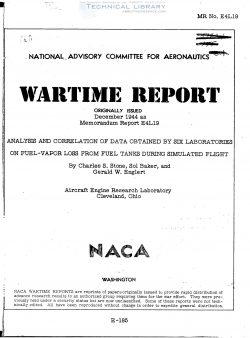naca-wr-e-185
- Version
- 101 Downloads
- 1.36 MB File Size
- 1 File Count
- April 15, 2017 Create Date
- April 15, 2017 Last Updated
Analysis and Correlation of Data Obtained by Six Laboratories on Fuel-Vapor Loss from Fuel Tanks During Simulated Flight

The fue1~vapor loss from an aircraft fuel tank during flight
is controlled by flight variables and by fuel characteristics. Some
of the basic concepts relating fuel characteristics to the problem
of fuel—vapor loss have been investigated in connection with
studies made on vapor—locking of fuel systems. The changes in fuel
characteristics during flight. the effect of weathering, and the
effect of air dissolved in the fuel on the vapor—locking tendencies
of the fuel, as well as a method of reducing fuel—vapor loss by
cooling the fuel before flight, have been discussed in several
progress reports of the Coordinating Research Council. The factors
affecting fueldvepor loss discussed herein include altitude, ini—
tial fuel temperrture. rate of climb, booster—gump agitation. fuel
depth, fuel—surface area, types of fuel, and vent—line pressure
drou.
Data covering the effect of these variables on fuel-vapor loss
were obtained in 19M} and 19%“ by six laboratories — Boeing Aircraft
Company, Hash Engineering Company. Ohio State University Research
Fcundation, Pesco Products Company, Pratt & Whitney Aircraft, and
Thompson Products, Inc. — for the Army Air Forces. Air Technical
Service Command, and the navy Department, Bureau of Aeronautics.
At the request of the Army Air Forces, these data were analyzed
atufihe NACA Cleveland laboratory during August and September of
19.
The apparatus used by each of the‘six“1aboratories is listed
in table I for comparison. In general, the apparatus consisted of
a fuel tank subjected to altitude pressures by a vacuum pump, a
means of measuring fuel loss during the test, and a means of con-
trolling and measuring the fuel temperatures. The simulated-flight
control usually consisted of a manually or automatically operated
bleed valve in the line between the vacuum pump and the fuel tank
for regulating the rate of climb and the altitude. The altitude
pressure was measured by a manometer connected to the outer end of
the vent line, by a manometer connected to the inside of the fuel
tank, or both. The amount of fuel—vapor loss was found by measuring
the change in fuel weight of a fuel tank mounted on a balance, by
measuring the change in fuel volume with a calibrated glass window
in the tank, or by condensing the escaping fuel vapor and taking
volume measurements of the condensate.
| File | Action |
|---|---|
| naca-wr-e-185 Analysis and Correlation of Data Obtained by Six Laboratories on Fuel-Vapor Loss from Fuel Tanks During Simulated Flight.pdf | Download |

Comment On This Post